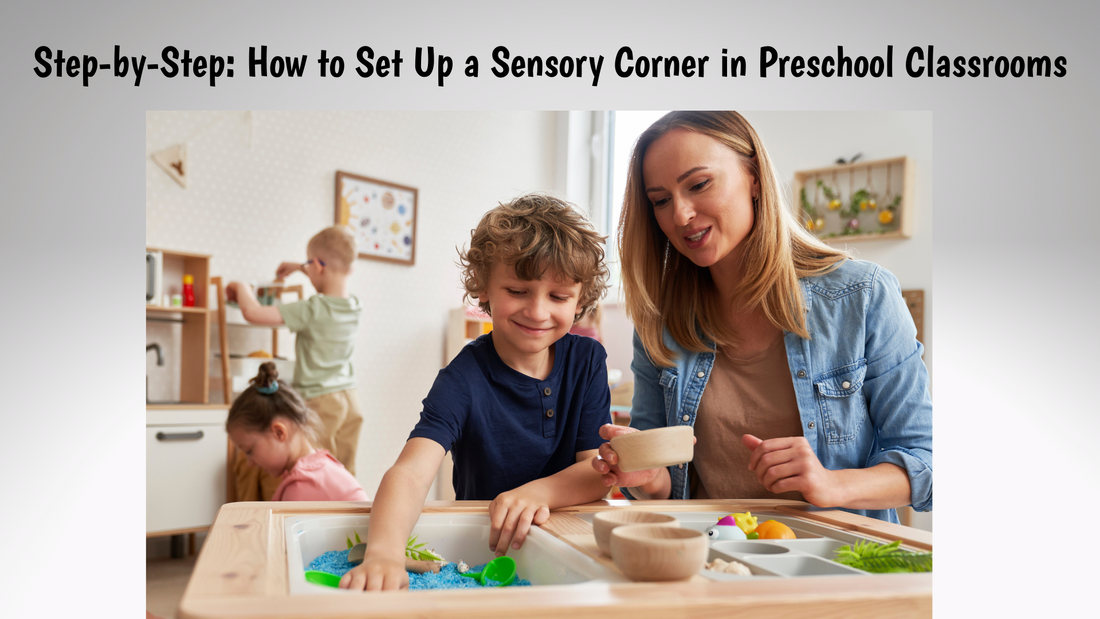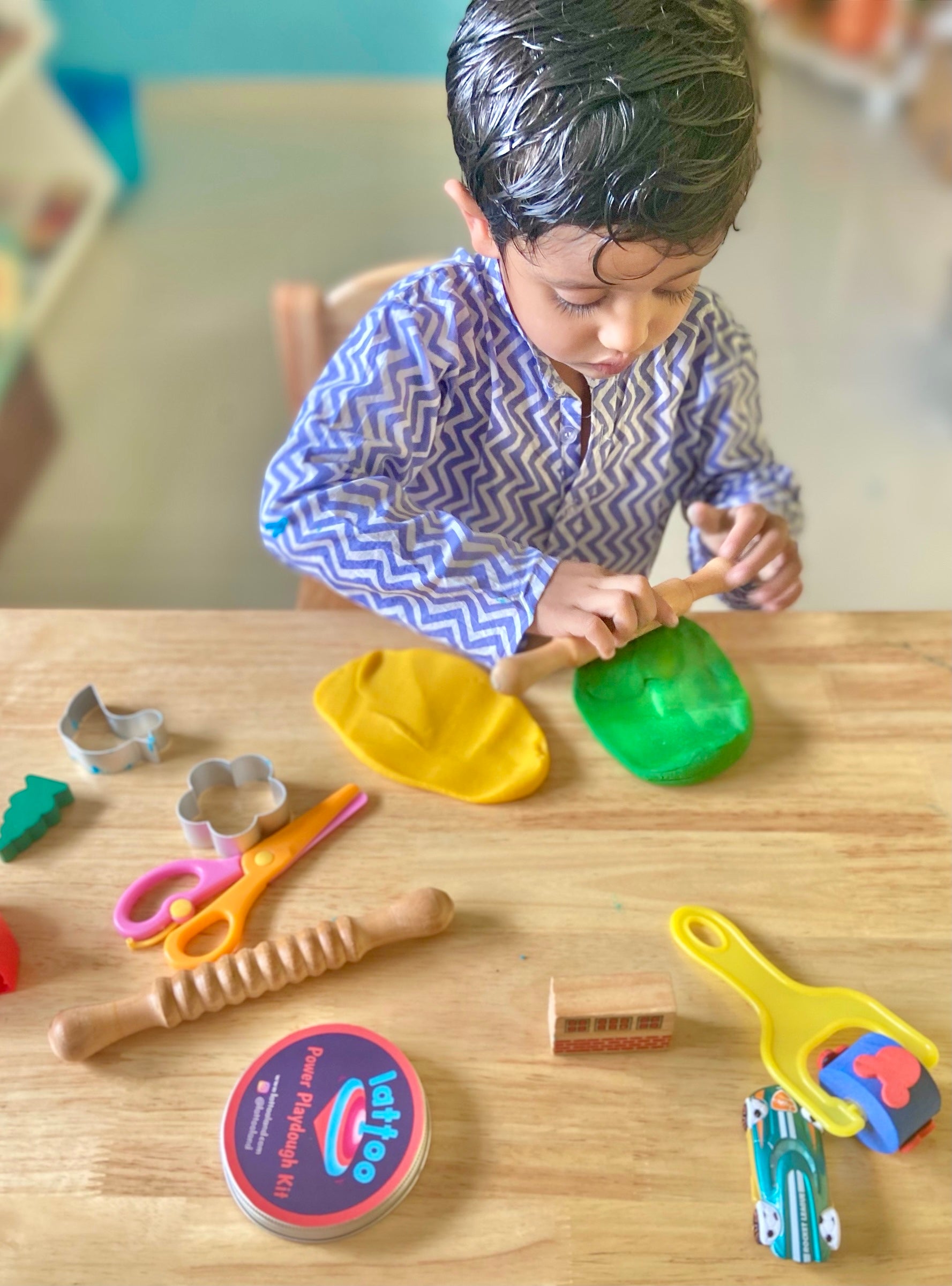Step-by-Step: How to Set Up a Sensory Corner in Preschool Classrooms
Creating a sensory corner in preschool classrooms is one of the best ways to support early childhood development. At Lattooland, we believe that hands-on, interactive learning is key to helping children explore the world around them. Sensory play stimulates a child’s senses—touch, sight, sound, and sometimes taste and smell while boosting cognitive, emotional, and motor skills.
Here’s a step-by-step guide to help teachers set up an engaging sensory corner in their preschool classrooms.
Why a Sensory Corner is Important
A sensory corner is not just a fun play area—it plays a crucial role in:
-
Developing fine motor skills: Activities like pouring, scooping, and manipulating materials strengthen hand-eye coordination.
-
Boosting creativity: Open-ended materials encourage imaginative play.
-
Regulating emotions: Sensory play can help children calm down and focus.
- Enhancing cognitive development: Sorting, classifying, and problem-solving activities build early learning skills.
Step 1: Choose the Right Space
When setting up a sensory corner in a preschool classroom, selecting the right space is crucial for effective learning and exploration. Consider the following points:
-
Quiet and Low-Traffic Area
* Choose a corner where children can focus without distractions.
* Minimizes interruptions from other classroom activities.
-
Well-Lit Space
* Preferably with natural light to make the area inviting.
* Helps children clearly see colors, textures, and materials.
-
Easy-to-Clean Area
* Sensory activities like sand, water, rice, or paints can get messy.
* Use flooring or mats that are easy to wipe down.
* Keep cleaning supplies handy for quick maintenance.
-
Safe and Comfortable
* Ensure there is enough space for children to move freely.
* Avoid sharp edges or obstacles.
* Use cushions or soft mats for added comfort.
-
Accessible and Visible
* Materials should be within children’s reach.
* Clear visibility allows teachers to supervise easily.
Selecting the right space ensures a calm, organized, and engaging sensory corner where children can explore, learn, and develop their sensory and motor skills safely.
Step 2: Decide on the Sensory Materials
A well-rounded sensory corner engages children through touch, sight, sound, smell, and taste. Here are ideas for each sense:
-
Touch :
For tactile exploration, children can engage with materials such as sand, water, rice, or beans, allowing them to experience different textures and sensations. Playdough and molding materials help develop fine motor skills, strengthening hand-eye coordination and dexterity. Additionally, incorporating textured mats and fabrics provides a variety of sensory experiences, encouraging children to explore and interact with different surfaces while enhancing their tactile awareness.
-
Sight
For visual stimulation, brightly colored toys and objects can capture children’s attention and encourage exploration. Sensory bottles filled with glitter, beads, or water offer dynamic visual experiences that fascinate and engage young learners. Mirrors provide opportunities for self-recognition and reflective play, helping children understand themselves and their surroundings. Additionally, light tables allow children to explore colors, shapes, and patterns in a hands-on, interactive way, further enhancing their visual development and creativity.
-
Sound
For auditory development, small musical instruments such as drums and xylophones can engage children in hands-on sound exploration. Shakers, bells, and soft rattles provide additional opportunities for auditory learning, helping children distinguish different tones and rhythms. Encouraging children to create and experiment with sounds allows them to express creativity while developing listening skills, concentration, and an early appreciation for music.
-
Smell
For olfactory stimulation, scented playdough or aroma jars filled with safe herbs and spices can engage children’s sense of smell in a fun and interactive way. Introducing mild, pleasant scents helps children explore different aromas, enhances sensory awareness, and encourages curiosity while creating a calming and enjoyable learning environment.
-
Taste-Safe Sensory Product
For taste-based sensory experiences, safe edible materials such as cereal, fruit slices, or yogurt can be used under supervision. These activities allow children to explore different flavors and textures, enhancing their sensory awareness while making learning both fun and engaging.
By including a variety of textures, colors, and sounds, a sensory corner can fully engage children’s senses, encouraging creativity, learning, and development.
Step 3: Organize Storage and Accessibility
A well-organized sensory corner ensures children can explore materials safely and independently. Key points to consider:
-
Use Clear Bins or Labeled Containers
* Store materials in transparent bins for easy visibility.
* Label containers with text or pictures to help children identify contents.
* Encourages independence as children can select materials themselves.
-
Keep Materials at Child-Friendly Height
* Place items within easy reach to promote self-access.
* Avoid stacking materials too high to prevent accidents.
* Helps children feel confident and in control of their play.
-
Rotate Materials Regularly
* Introduce new items periodically to maintain engagement.
* Rotate tactile, visual, and auditory materials to stimulate different senses.
* Keeps the sensory corner fresh and encourages ongoing exploration.
-
Organize by Activity Type
* Group materials by touch, sight, sound, and smell for easy navigation.
* Helps children understand different sensory experiences.
-
Maintain Cleanliness and Safety
* Ensure containers are sturdy and easy to clean.
* Remove broken or unsafe items promptly.
Proper storage and accessibility enhance independence, engagement, and safety, making the sensory corner an inviting space for continuous learning and exploration.
Step 4:Design a Comfortable and Safe Area
-
Add Soft Mats or Cushions
* Provide cozy seating for children during sensory play.
* Reduce the risk of bumps or falls and make the space inviting.
-
Use Non-Toxic, Age-Appropriate Materials
* Ensure all toys, paints, and sensory items are safe for preschoolers.
* Avoid small parts or hazardous materials that could cause accidents.
* Check labels for safety compliance.
-
Create Defined Zones for Activities
* Separate areas for touch, sight, sound, and smell activities.
* Keeps the sensory corner organized and prevents chaos.
* Helps children explore independently and stay focused.
-
Maintain Visibility and Supervision
* Keep pathways clear for easy monitoring.
* Ensure children can safely move between zones without collisions.
-
Encourage Relaxation and Engagement
* A safe and structured space allows children to explore freely.
* Supports sensory development, creativity, and focused learning.
Step 5: Integrate Learning Goals
-
Incorporate Math Skills
* Use sensory materials to practice counting objects, like beads or blocks.
* Encourage measuring, pouring, and comparing quantities.
* Sorting activities help children recognize patterns, shapes, and sizes.
-
Support Language Development
* Ask children to describe textures, colors, and shapes of materials.
* Encourage storytelling during play to build vocabulary and communication.
* Use sensory activities to introduce new words in a fun, hands-on way.
-
Foster Social Skills
* Promote sharing and turn-taking while using materials.
* Encourage collaboration through group activities and cooperative tasks.
* Build empathy and patience as children learn to respect each other’s space and choices.
-
Combine Learning with Exploration
* Sensory play naturally engages curiosity while supporting educational goals.
* Integrating structured learning helps children develop cognitive, social, and language skills effortlessly.
Step 6: Introduce Children to the Sensory Corner
-
Explain Rules for Safe Use
* Teach children how to handle materials carefully.
* Emphasize sharing, respecting each other’s space, and keeping the area tidy.
* Set clear guidelines for which materials are edible, messy, or fragile. -
Demonstrate Activities
* Show a few examples of how to explore textures, colors, or sounds.
* Use simple, fun demonstrations to spark curiosity and interest.
* Encourage children to imitate or adapt the activity creatively. -
Encourage Free Exploration
* Allow children to experiment with materials on their own.
* Let them combine, mix, or manipulate objects to discover new experiences.
* Foster imagination by avoiding strict instructions and giving room for creativity. -
Observe and Guide Gently
* Step in only when safety or guidance is needed.
Support independent learning while encouraging curiosity and experimentation.
Step 7: Observe and Adapt
-
Watch How Children Interact
* Carefully observe how each child uses the sensory materials.
* Take note of preferences, strengths, and challenges.
* Identify which items spark curiosity and sustained engagement.
-
Adjust Activities Based on Observation
* Introduce new materials or modify activities to better suit children’s interests.
* Remove or replace items that are less engaging or no longer appropriate.
* Tailor experiences to support learning goals, such as fine motor skills or cognitive development.
-
Rotate Materials Regularly
* Swap out toys, textures, or sensory items to maintain novelty and excitement.
* Introduce seasonal, thematic, or new materials to expand exploration.
* Keep the sensory corner fresh to encourage continuous learning.
-
Encourage Reflection and Feedback
* Discuss favorite activities with children.
* Adapt strategies to meet evolving needs and developmental milestones.
Bonus Tips for a Successful Sensory Corner
-
Choose a Quiet Spot : Place the corner away from distractions to create a calming environment.
-
Use Soft Lighting : Gentle lights or lamps make the space soothing and inviting.
-
Keep It Organized : Use bins or baskets to store sensory items neatly.
-
Rotate Materials : Switch out toys and textures regularly to keep children engaged.
-
Include Comfortable Seating : Add cushions, bean bags, or rugs for relaxation.
-
Offer Variety : Mix textures, sounds, and visuals for a rich sensory experience.
-
Ensure Safety : Use age-appropriate, non-toxic, and supervised items.
-
Personalize the Space : Include items your child enjoys most to make it welcoming.
-
Encourage Choice : Let children pick what they want to explore for independent play.
- Keep It Small & Simple : A sensory corner doesn’t need to be big; a cozy, well-planned spot works best
A thoughtfully designed sensory corner can be a powerful addition to preschool learning. Using Lattooland Classroom Kits filled with rice, dough, and sensory tools, you can create an inviting space with cozy seating, calming lights, and engaging bins for hands-on exploration. This safe and stimulating environment encourages creativity, supports cognitive development, and helps children regulate their emotions all while making learning fun.
The best part? Setting up your sensory corner is simple and stress-free. Start small, observe your students, and gradually expand it into a vibrant hub of sensory learning.











